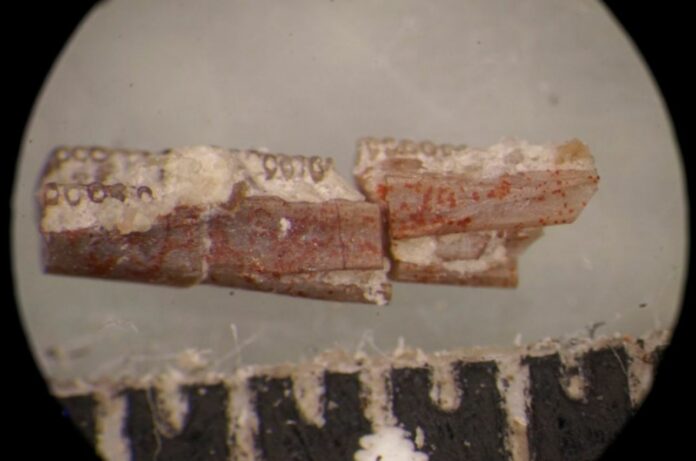Paleontologists from Virginia Tech, the U.S. Petrified Forest National Park, and other institutions have found the first clear Triassic-era caecilian fossil, the oldest-known caecilian fossils, extending the history of this small, burrowing mammal by approximately 35 million years. This discovery also fills a gap of at least 87 million years in the known fossil record of the amphibian-like creature. The fossil was initially co-discovered by Ben Kligman, a doctoral student in the Virginia Tech College of Science’s Department of Geosciences, at Arizona’s Petrified Forest National Park in 2019.
The fossil, which was discovered by Kligman and given the name Funcusvermis gilmorei, pushes the origin of caecilians back in time by 35 million years, to the Triassic Period, which occurred about 250 million to 200 million years ago.
Before today’s research, just 10 caecilian fossil occurrences going back to the Early Jurassic Period (about 183 million years ago) were known.
Kligman claims that despite the 87-million-year gap, prior DNA analyses placed the evolutionary beginnings of caecilians in the Carboniferous or Permian ages, between 370 million and 270 million years ago. But no such fossils have ever been discovered.
“The discovery of the oldest caecilian fossils highlights the crucial nature of new fossil evidence. Many of the biggest outstanding questions in paleontology and evolution cannot be resolved without fossils like this,” adds Kligman, who previously discovered a 220-million-year-old species of cynodont or stem-mammal, a precursor of modern-day mammals. “Fossil caecilians are extraordinarily rare, and they are found accidentally when paleontologists are searching for the fossils of other more common animals. Our discovery of one was totally unexpected, and it transformed the trajectory of my scientific interests.”
The fossils were found in 2019 by Kligman and Xavier Jenkins, a former Petrified Forest National Park student intern who is now a Ph.D. student at Idaho State University. The two were using a microscope to look at fossil-rich sediment from the park’s Thunderstorm Ridge.
Funcusvermis was found in a layer of the Chinle Formation that dates back about 220 million years, when Arizona was in the middle of the supercontinent Pangaea near the equator. At the time, the weather in this area was hot and humid. Arizona is hot yet dry today.
“Seeing the first jaw under the microscope, with its distinctive double row of teeth, sent chills down my back,” Kligman adds. “We immediately knew it was a caecilian, the oldest caecilian fossil ever found, and a once-in-a-lifetime discovery.”
Before this find, an 87-million-year gap in the fossil record hid the early evolution of caecilians. This led scientists to argue for decades about how caecilians are related to frogs and salamanders, which are amphibians.
According to Kligman, “funcusvermis extends the humid equatorial pattern of occurrence seen in all known fossil and living caecilians, suggesting that the biogeographic history of caecilians has been guided by restriction to these ecological settings, likely due to physiological constraints linked to humidity, and constrained by the drift of continental plates into and out of the humid-equatorial zone after the fragmentation of Pangaea.”
Modern caecilians have cylindrical bodies, no legs, and a small, bullet-shaped cranium that makes it easier for them to burrow.
Currently only found in South and Central America, Africa, and southern Asia, caecilians spend their whole lives digging in dirt or leaf litter in search of worms and other small animals.
Scientists have found it challenging to research caecilians due of their subterranean life. With a smile, Kligman calls contemporary caecilians “an eyeless sock puppet with the body of a worm.”
Funcusvermis actually has skeletal traits that are more similar to early frog and salamander fossils, bolstering evidence for a common origin and close evolutionary link between caecilians and these two groups.
Additionally, Funcusvermis’ skeleton is similar to that of an extinct group of frogs called the dissorophoid temnospondyls, according to paleontologists.
“Unlike living caecilians,” according to Kligman, “Funcusvermis lacks many adaptations associated with burrowing underground, indicating a slower acquisition of features associated with an underground lifestyle in the early stages of caecilian evolution.”
The genus name ‘Funcusvermis’ was inspired by the Ohio Players’ 1972 song “Funky Worm” from their album Pleasure, a favorite song of the authors who often listened to it while collecting fossils at Thunderstorm Ridge.
The word “funcus” comes from the Latinized version of the English word “funky,” which means fast-paced, rhythmic dance music. The word “vermis” comes from the Latin word for “worm.”
The name “gilmorei” is in honor of Ned Gilmore, who was in charge of the collections at the Academy of Natural Sciences at Drexel University in Philadelphia.
Since 2019, significant discoveries have been made at Petrified Forest National Park. As of summer 2022, the lower jaws of at least 70 Funcusvermis individuals have been found, making the area the most abundant source of caecilian fossils ever discovered. However, only a small number of bones have been discovered, such as upper and lower jaws, a vertebra, and part of a hind-limb, all of which were found disarticulated and not as complete skeletons.
Kligman and his colleagues are unable to precisely estimate the body size of Funcusvermis in the absence of full skeletons, but isolated features, such as the lower jaw’s measurement of less than a quarter of an inch, suggest that Funcusvermis was a small animal.
“Since its discovery in 2017, the Thunderstorm Ridge site has produced a diverse assemblage of over 60 animals ranging from freshwater sharks to dinosaurs,” Kligman adds. “Several other new species discovered at this site have been recently described. Many other new species from this site are currently under study and will be published in upcoming years.”
In other words, paleontologists should be ready for more changes to what they know about the history of fossils.
Image Credit: Ben Kligman for Virginia Tech
